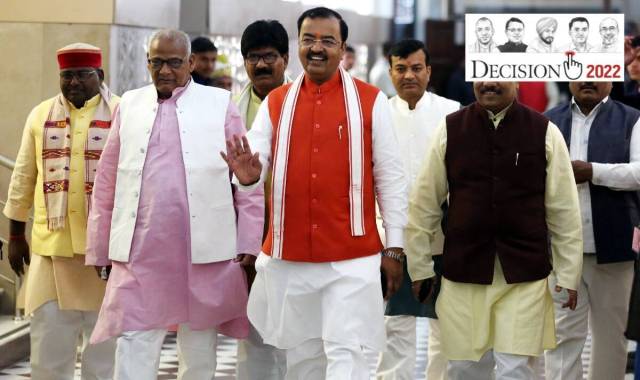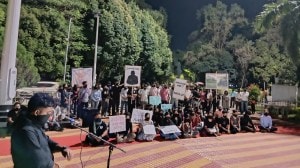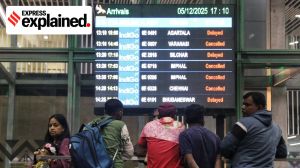For Keshav Prasad Maurya, Deputy Chief Minister in the Yogi Adityanath government, it’s a high-stakes battle in Sirathu, an Assembly seat in Uttar Pradesh’s Kaushambi district where caste equations have traditionally held the key.
Dominated by the three Ps – Pasis (Dalits), Patels (Kurmis, an OBC community) and Pandits (Brahmins) – Maurya, the party’s OBC face, knows a win here is crucial to his political career notwithstanding the party’s performance in the rest of the state.

With a week to go for the polls, Maurya told The Indian Express, “I am the son of this soil. I have contested and won from here before. I know the problems here. I have no doubt about my victory. I will win by a record margin.”
On the ground, however, many openly express their annoyance with Maurya’s “lack of accessibility” and cite the fact that little has been done for the seat despite the high position he holds in the Yogi Cabinet.
Sirathu goes to the poll on February 27 in the fifth phase of elections.
Abhishek Kumar Pasi, from Bidanpur Amad Karari in Sirathu, says, “I worked for Keshav ji last time when he was elected from here. But I have decided not to vote for him this time… he did not do anything for us.”
At a Patel dominated village in the constituency, the owner of a Common Service Centre (CSC), speaking on the condition that he and his village won’t be identified, said, “I don’t know who is going to vote for Maurya ji. More than 50 people visit my CSC every day and almost all of them seem unhappy with him. They say that as Deputy CM, he did nothing for the area.”
Story continues below this ad
Maurya, who hails from Sirathu, last won from here in 2012, but resigned the Assembly seat after he won the 2014 Lok Sabha election from Phulpur. In 2017, when he joined the Adityanath government, he quit his Lok Sabha seat and was elected to the legislative council. In the 2017 election, BJP’s Sheetla Prasad defeated SP’s Vachaspati by over 26,000 votes.
This election, he is up against Pallavi Patel of the Apna Dal (Kamerawadi), which is part of the SP-led alliance. Elder sister of Union minister Anupriya Patel, who is part of the rival faction of the Apna Dal, Pallavi’s campaign has been focused on the Patels, Muslims and Yadavs.
 In the 2017 election, BJP’s Sheetla Prasad defeated SP’s Vachaspati by over 26,000 votes.
In the 2017 election, BJP’s Sheetla Prasad defeated SP’s Vachaspati by over 26,000 votes.
Says Raj Kumar Saroj, Pallavi’s election office-incharge at Sirathu, “A few Pasi votes may go to the BJP, but the majority is with us. Pallavi ji’s victory is certain.”
The Pasis are among the biggest communities here, estimated to number over 60,000, followed by the Patels, Gautams (another Dalit caste) and the Maurya-Kushwahas. Among others, the Brahmins and the Yadavs also number around 20,000 each.
Story continues below this ad
Sources say that despite facing a seemingly tough battle, Maurya may have played his cards right in Sirathu, tactfully ensuring that the alliance candidates in neighbouring constituencies tick the right caste boxes.
In neighbouring Chail, for instance, the BJP replaced sitting MLA Sanjay Gupta with Nagendra Pratap Singh Patel, a SP leader who is now in the Apna Dal (S), a BJP ally. BJP sources say it’s part of a strategy to keep Patel (Kurmi) voters in the larger area connected to the BJP and its allies, thus benefiting Maurya.
Similarly, Vachaspati, the SP runner-up in the 2017 election, is a Pasi leader from Sirathu and is now the Apna Dal (S)’s candidate in Bara, a reserved constituency in Prayagraj. BJP sources say his presence in the region will help Maurya woo Pasi votes.
BJP sources say BSP’s decision to change its candidate may also work in Maurya’s favour. The BSP, which earlier fielded Santosh Tripathi, a Brahmin, replaced him with Munsab Usmani. Party sources hope the split in minority votes between the SP and BSP will work in Maurya’s favour.



 In the 2017 election, BJP’s Sheetla Prasad defeated SP’s Vachaspati by over 26,000 votes.
In the 2017 election, BJP’s Sheetla Prasad defeated SP’s Vachaspati by over 26,000 votes.





























